April 2021
The most recent lockdown has had a more muted impact on the labour market, with employment and vacancies showing signs of recovery
Employment fell by 73,000 in December to February 2021 compared to the previous quarter and is 643,000 lower than a year ago. The timelier measure of PAYE employees fell by 56,000 in March 2021 compared to the previous month, and is 813,000 lower than a year ago.
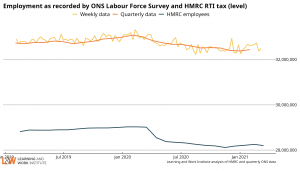
Unemployment is 311,000 higher than a year ago, but 50,000 lower in December to February 2021 than in the previous quarter. The number of people claiming unemployment-related benefits rose by 10,100 in March 2021 compared to the previous month, to stand at 2.67 million.
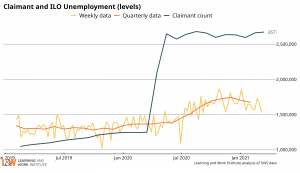
After a sharp initial impact in spring 2020, there have been smaller changes in employment and unemployment overall than would be expected given the fall in economic output. We estimate unemployment would be around 2.5 million higher had it followed the path of economic output.
The number of job vacancies has also recovered, after falling around two thirds during the first lockdown in spring 2020. The number of online vacancies as measured by Adzuna is now back to its pre-crisis levels. However, significant sector impacts can still be seen: catering and hospitality vacancies are still 42% lower than in March 2020, while transport, logistics and warehouse vacancies are 90% higher.
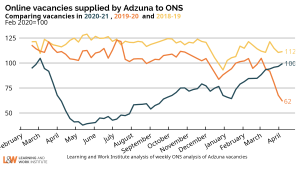
The number of hours worked is also recovering, but remains below pre-pandemic levels as the furlough scheme protects jobs
The furlough scheme and other economic support have protected millions of jobs. Instead, more of the labour market adjustment to the crisis has come in people working fewer hours, including those who were furloughed.
The latest data show the total number of hours worked rose in the last two weeks in March 2021 to 93% of the February 2020 level after an earlier reduction. This reflects the end of the latest lockdown, with the number of people furloughed rising to 4.6 million in February 2021, compared to 4 million in December 2020.

The easing of lockdown is likely to lead to a falling number of people furloughed and an increase in hours worked in the months ahead. However, there is uncertainty about how many jobs will return as the furlough scheme ends in September. The Office for Budget Responsibility projected a rise in unemployment of 500,000 by the end of 2021, a lower increase than previously expected but still a significant rise.
Young people continue to be among those hardest hit
Young people account for 57% of the fall in employment, despite accounting for just 12% of total employment. As a result, the number of unemployed 16-24 year olds has risen 61,000 over the last year and 504,000 18-24 year olds are claiming unemployment-related benefits, double pre-crisis levels.
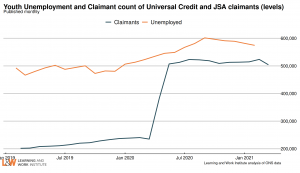
In addition, the number of young people unemployed for 6 months or more has increased again. There were 220,000 long term unemployed young people in December to February 2021, up 16% on the previous quarter, and 51% on a year before.

We have argued for a Youth Guarantee to ensure all 16-24 year olds are offered a job, training place or apprenticeship.
The longer you are out of work, the more difficult it can be to return to employment and long term unemployment can have a negative impact on health and wellbeing. Similar, albeit milder impacts, may affect those who have been furloughed for a long period of time and subsequently lose their jobs.
Long-term unemployment is likely to rise further in the coming months. Delivery of the DWP’s Restart programme to support this group won’t start until summer 2021. The number of long term unemployed jobseekers may significantly exceed spaces on the programme at its start.
The labour market starting points and impacts of the crisis vary significantly, providing the backdrop to local and Mayoral elections
In early May elections take place in Scotland, Wales and large parts of England, including Mayoral elections in Mayoral Combined Authorities and London.
The labour market starting points of each varied significantly: the proportion of people claiming unemployment-related benefits in March 2020 varied from 2.1% in both Cambridgeshire and Peterborough and the West of England to 5.4% in the West Midlands.
The impacts of the crisis have also varied, with the proportion of people claiming unemployment-related benefits rising by 5.4 percentage points in London in the last year and 2.7 percentage points in North of Tyne and Wales.
At more local level, our analysis showed that the number of people claiming unemployment-related benefits rose three times faster in areas with higher pre-crisis unemployment than in the lowest unemployment areas.
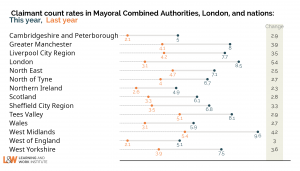
Ensuring a jobs recovery that also tackles pre-existing inequalities will be a key priority for all of those elected on May 6th. These data show the challenges vary significantly, requiring a locally tailored approach. As much employment and skills policy is driven by the UK government, this will also require a partnership between national and local government.